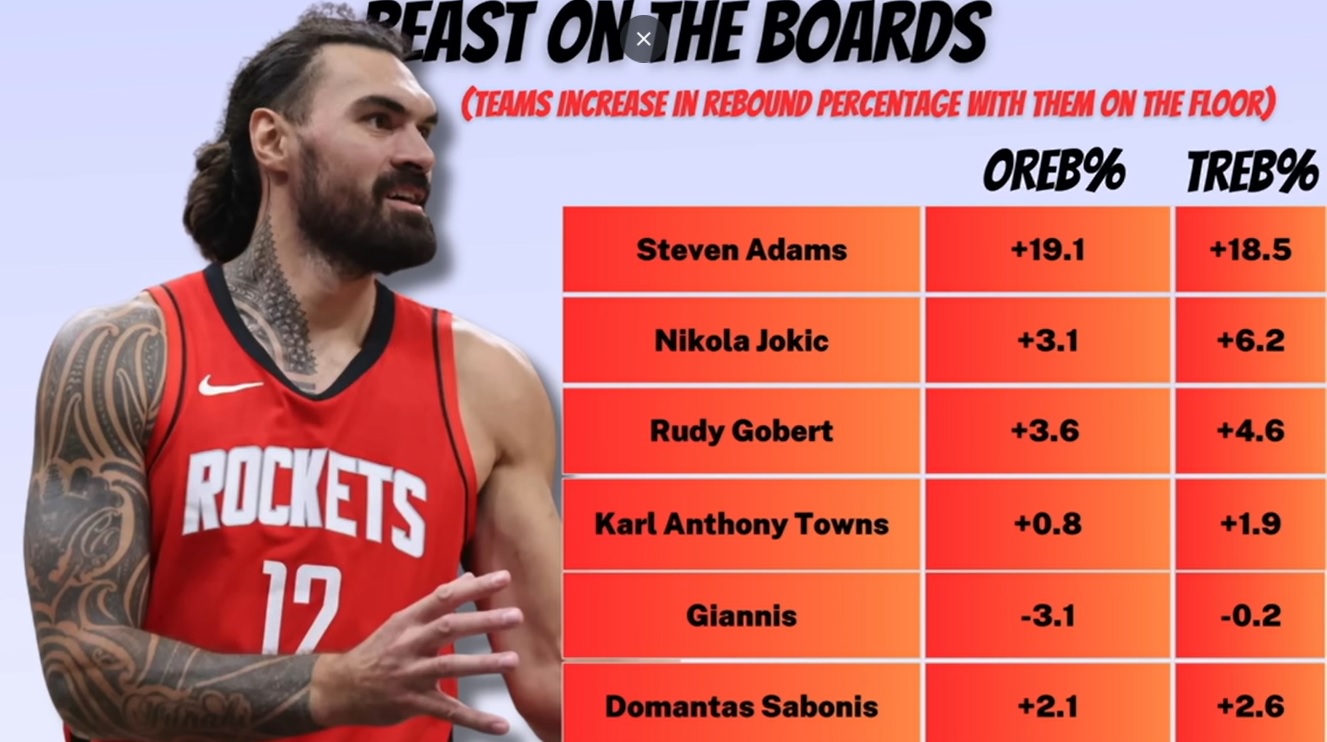In NBA analytics, some stats cut through the hype and reveal uncomfortable truths. The “BEAST ON THE BOARDS” chart illustrates how star big men’s presence impacts their team’s rebound percentages. Players like Steven Adams (+19.1 OREB%, +18.5 TREB%) and Nikola Jokic (+3.1, +6.2) boost their squads, living up to their reputations as rebounding forces. But then there’s Giannis Antetokounmpo, with negative differentials: -3.1 OREB% and -0.2 TREB%. This isn’t a glitch—it’s a pattern that questions the “Greek Freak’s” true impact.
Giannis posts gaudy individual numbers, averaging double-digit rebounds most seasons, but the team’s rebounding suffers when he’s on the floor. Why? It’s not just about team dynamics; it’s tied to Giannis’ evolving priorities, defensive shortcomings, and a focus on personal stats over team success. Since his 2019-20 Defensive Player of the Year (DPOY) award, his defence has declined, he’s emphasised offence, chased highlights, and padded rebounds—often at the expense of cohesive play. Let’s break it down with data and context.
Understanding On-Off Rebound Percentages
Before we dissect Giannis’ case, let’s clarify the stat. Rebound percentage measures the share of available rebounds a team (or player) secures while on the court. It’s more insightful than raw rebounds because it accounts for pace and opportunities—after all, a fast-paced game might have more misses, but the percentage normalizes that.
- OREB%: The percentage of a team’s own missed shots that they rebound (offensive rebounds / (offensive rebounds + opponent’s defensive rebounds)).
- TREB%: The overall rebound percentage, combining offensive and defensive boards.
The “on-off differential” compares the team’s performance in these metrics when a player is on the court versus off. A positive number means the team rebounds better with the player playing; a negative means they rebound better without them.
Data from sites like Cleaning the Glass shows this isn’t a one-off fluke for Giannis. In the 2021-22 season (which aligns closely with the chart’s numbers, showing -2.8 OREB% on-off), and other years like 2018-19 (-1.2%) and 2020-21 (-1.9%), Giannis posted negative differentials. Yet, in more recent seasons like 2023-24 (+2.6 OREB%) and 2024-25 (+1.8%), it’s flipped positive. So, what’s going on?
Giannis’ Individual Stats: Impressive, But Inflated?
Giannis ranks among the league’s top rebounders, but scrutiny reveals issues:
| Season | Rebounds Per Game (RPG) | Total Rebound % (TRB%) | Defensive Rating (DRtg) | Defensive BPM (DBPM) |
|---|---|---|---|---|
| 2019-20 | 13.6 | 21.4% | 97 | 4.1 |
| 2020-21 | 11.0 | 18.5% | 107 | 2.8 |
| 2021-22 | 11.6 | 19.2% | 106 | 3.5 |
| 2022-23 | 11.8 | 19.8% | 108 | 2.7 |
| 2023-24 | 11.5 | 18.8% | 112 | 2.4 |
| 2024-25 | 11.9 | 19.5% | 109 | 2.5 |
(Source: Basketball-Reference)
His RPG and TRB% are solid, but notice the defensive metrics. Post-DPOY (where he posted a league-best 97 DRtg), his DRtg has worsened to 107-112, indicating more points allowed per 100 possessions. DBPM, measuring defensive impact, dropped from 4.1 to as low as 2.4. This decline correlates with negative rebound diffs, as poor defence leads to more opponent makes—and fewer rebound chances.
The Shift: From Defensive Anchor to Offensive Focus
Giannis won DPOY in 2019-20 as a versatile defender, using his 7-foot wingspan for help defence and rim protection. But since then, his effort has waned. Analysts note he’s prioritised offence over grinding on D. Bucks’ schemes rely on him as a free safety, but he often chases “highlight reel” plays—spectacular blocks or steals—instead of sticking to plans.
This individualism disrupts team rebounding. Teammates “clear out” on misses, letting Giannis grab easy defensive boards to pad stats, rather than contesting collectively. A notorious 2023 incident saw him intentionally miss a shot for his own rebound to secure a triple-double, later rescinded by the NBA amid “stat-padding” backlash. Fans and media called it “shameless,” highlighting a pattern where personal milestones trump team efficiency.
Defensive Shortcomings: Speed, Switching, and Fundamentals
Giannis’ late start in basketball—he didn’t play organised ball until age 13 in Greece—shows in his reflexes and scheme comprehension. Unlike peers who honed instincts young, he struggles with complex switches in modern pick-and-roll defences. He’s not fast enough laterally to guard perimeter threats, often getting blown by or mispositioned. This leads to breakdowns: Opponents exploit gaps, leading to more makes and fewer Bucks rebounds.
In high-pace lineups with Giannis, the team leaks out for transitions, but his defensive lapses mean more opponent scores—reducing OREB% opportunities. Bench units, without him, play more structured, grabbing boards at higher rates. Social media discussions echo this: “Giannis was only ever a helpside defender… not much of a rim protector.” His blocks (around 1-1.5/game post-DPOY) are flashy but don’t anchor like Gobert’s.
Lineup and Opponent Factors: Excuses or Reality?
Sure, roster changes matter—Brook Lopez’s injuries forced adjustments, and backups like Bobby Portis (16.5% TRB% in 2021-22) feast in non-Giannis minutes. But this masks Giannis’ issues. He faces starters, but his declining DBPM suggests he’s not elevating the unit. Bucks’ overall TREB% (50-52%) is average, but negatives persist because Giannis’ style—offence-first, stat-chasing—trades team rebounding for personal glory.
He’s in his prime physically but coasting defensively.
Time for Accountability
Giannis’ negative on-off rebound diffs aren’t a paradox—they’re a symptom of prioritising offence, highlights, and stats over defence and team play. His late basketball start hampers reflexes in schemes, and rebound “padding” inflates numbers while hurting the Bucks. Milwaukee won in 2021 despite this, but as defences evolve, Giannis must recommit defensively. In 2025-26, under Doc Rivers, watch if he adapts—or if the illusion crumbles further.




